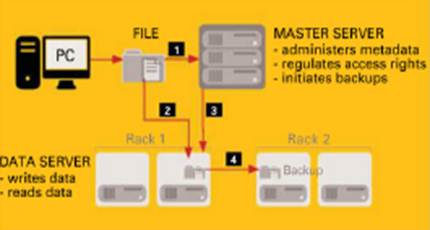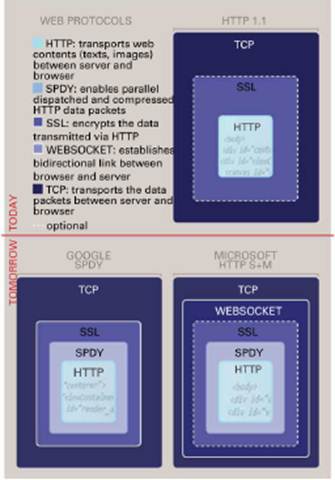More surfers, more data and more
services: the web is increasing by leaps and bounds, made possible by new
technology and improved coding. We look beyond orizon to see what lies ahead
for the Internet
The generation that has learnt to surf the
net before they can even walk is already among us. Accessing the Internet is as
natural to them as breathing; an integral and integrated part of life. It would
be great if the future of the Internet is shaped like this: Accurate, Fast and
Secure. And only those technologies that can keep up with the growth of the
Internet can guarantee this. Some of these are being implemented today, but
they'll need time. Expansion of existing IP addresses with the introduction of
the IPv6 protocol has been going on for many years. And the introduction of the
Domain Name System Security Extensions (DNSSEC), which ensures the authenticity
of web addresses, will also take a while. In the meantime, new undersea cables
through the north-west passage of the Arctic are also being planned. These will
reduce the response time of a link to Japan by 60 milliseconds. The Internet of
the Future will not happen in just one massive explosion, and laying down miles
of cables is not the only solution to effectively direct the continuously
increasing data flow to the surfer. Instead, a mosaic of new software
technologies at different levels from the data centre of the browser will be
headlining the biggest changes. The new horizon for the Internet is arriving,
and we'll be looking beyond it to see what may very well be the Internet you'll
experience next year.

The
Internet Of The Future
Better control in data flow
To increase the speeds of processing
and sending Petabytes, one must uncouple software from hardware. Google shows
us how it can be done
The International Telecommunication Union
of the UN reported that one-third of the world's population was online in 2011,
and the bandwidth of the web on an average amounted to 90,000 gigabytes per
second. That is exactly 30 Exabyte in a month, and counting (refer to graph on
right). The debatable point here is how one can effectively control such a high
data flow. Google has now demonstrated this to large network suppliers like
Cisco and Juniper. This is hardly surprising: communication between Google's
data centres and web surfers themselves amounts to 6 to 10 percent of the
entire global traffic, according to a report by Arbor Network. As Google would
like to be the number one provider, it would not stay silent on the volume of
traffic between its data centres. At the Open Network Summit in April, Google
allowed a tiny insight into how one regulates the traffic between centres. It
came as a huge surprise since the concern had evidently said goodbye to customary
network architecture.
It is the norm for providers to expand
their network capacities by going to large suppliers and purchasing their
hardware along with the corresponding software. However, for the hardware,
Google directly negotiates with Chinese manufacturers and links the router and
switches via a Software Defined Network (SDN), which is controlled by the
OpenFlow protocol. This allows the administrator to centrally control the path
of the data packets in his network and avoid bottlenecks. He can assign greater
priority to backups, email traffic or video streams if necessary. Google
requires flexible control over the data flow because its internal network needs
to more many Petabytes of data in short notice. SDN will be taking over all
providers in the long term.
Who has the fastest file system in the
world?
The web carries out an increasing number of
tasks besides data transferring. The same applies to cloud services for
computers and data storage. For example, the EC2 cloud by Amazon accounts for
one percent of the entire Internet traffic. It stored an amount of 762 billion
data sets (Objects) last year and had processed 500,000 tasks per second. Only
file systems can ensure data integrity under high pressure; the administer the
metadata (name, size, date) separately from the intrinsic file content. The
Hadoop Distributed File System (HDFS) found in Facebook, Yahoo! and in the EC2
cloud will automatically create several copies and has a server at each node -
this siver is employed to only manage the metadata (refer right). Thus, it is
possible to manage many parallel accesses to Petabytes of data. This makes the
open-sourced file system HDFS one of the fastest in the world.
Forecast: steadily rising web traffic
The Visual Networking Index by Cisco supplies
the most exact data about web traffic. It forecasts a doubling for the next
three years - propelled also by mobile devices.

Forecast:
steadily rising web traffic
OpenFlow: Google's new network
OpenFlow organises the traffic between
Google's computing centers. The Open Source Technology can efficiently
distribute huge quantities of data as compared to the usual software for
routers and switches.

OpenFlow:
Google's new network
HDFS: A file system for petabytes
Only distributed file systems like the HDFS
can manage thousands of simultaneous accesses to huge quantities of data;
special servers are responsible for this administration.
If a file needs to be stored, the master
server seizes the file's metadata (name, size, etc.) 1 and the contents are written
on a data server 2. After that, the master server 3 gives the instruction for
reflecting the data contents in another rack 4.

HDFS:
A file system for petabytes
Stable Protocol for connections
No website arrives to the browser
without HTTP. Still, the protocol largely inefficient. Its successor is faster
by at least 50 percent
The Hypertext Transfer Protocol (HTTP), the
cornerstone of Internet communication, is pretty much out-of-date. The last
version (1.1) came out 13 years ago. As a complement to the TCP transport
protocol, which packs the data in individual packets, HTTP instead concerns
itself with requesting the contents of a website from the server and it
prescribes the way in which the elements of a website are dispatched. For this
purpose, HTTP 1.1 allows only one request per TCP connection. Thus, what
happens is that all the elements of a website (text, images and scripts) are
dispatched individually one after the other. Current browsers circumvent this
restriction by establishing six parallel TCP connections. That is still not
truly efficient enough, as one server can accommodate every additional
connection with a delay of 500 milliseconds, and it also sends along a new
redundant HTTP-Header with every connection - more data than it should
necessarily transfer. And moreover, the headers are dispatched in an
uncompressed manner. Furthermore, the protocol allows only the client to ask
questions. Even if the server itself knows that it should actually dispatch
more data still to the client, it must wait until the client requests the same.
HTTP also does not provide encryption. That is why additional protocols like
SSL are used.
Google and Microsoft Developing HTTP 2.0
The IETF (Internal Engineering Task Force)
wants to address the many disadvantages surrounding HTTP 1.1, and plans to
introduce Version 2.0 next year as a standard. It is to be decided this year as
to which technology will be employed. Google and Microsoft have respectively
made their own proposals, and they are being considered as hot candidates.
Google has already been using SPDY for two years. This is a protocol that both
modifies and complements HTTP 1.1. Firefox, Chrome and the Silk browser on
Kindle have already integrated SPDY; likewise, all Google services like Amazon,
Twitter and the Apache web server support this technology. SPDY allows HTTP
packets to be sent in a parallel manner, compresses the data and also provides
the compulsory SSL encryption. Reports have revealed that it accelerates data
transfers by up to 50 percent.
From Microsoft's perspective, however,
Google's concept neglects the requirements of applications in mobile devices.
Microsoft wants to resolve that with the HTTP Speed+Mobility protocol. It uses
the SPDY technology for parallelisation, but at the same time allows
flexibility for encryption and compression as both requires computing power and
also reduces battery life. Microsoft prescribes this using web sockets which
establish a constant bi-directional connection between the client and server -
a concept that matches the best with those apps which continuously send data to
the web or receive data for further processing. Whichever catches on, faster
Internet surfing will most likely be implemented next year.
HTTP 2.0: Two maps for the New Protocol
The new version of the web protocol ought
to be released next year. Two competing proposals from Google and Microsoft as
to how to optimize HTTP 1.1 are on the table at the moment.

HTTP
2.0: Two maps for the New Protocol
Firefox 13: Now already with HTTP 2.0
With Google's SPDY protocol, you can now
surf faster 1. It is by default activated both in Chrome and Firefox 13 2.
Users can test this on isspdyenabled.com.

Firefox
13: Now already with HTTP 2.0